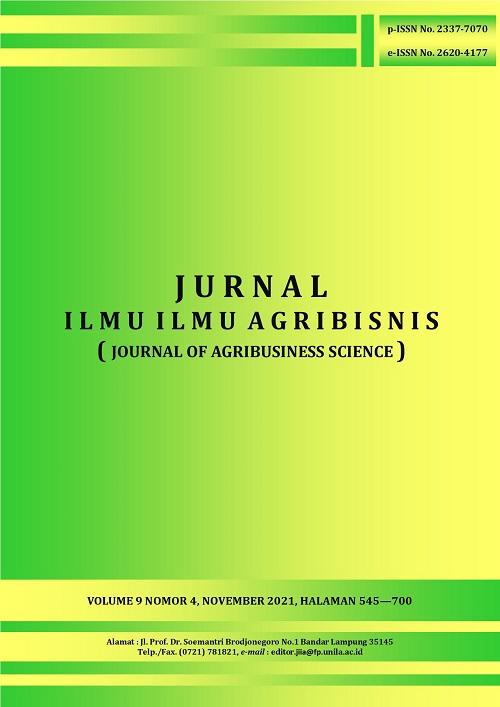PENDAPATAN USAHATANI TEBU RAKYAT DAN POLA KEMITRAAN PADA PETANI MITRA PT BUMA CIMA NUSANTARA, KABUPATEN LAMPUNG UTARA
DOI:
https://doi.org/10.23960/jiia.v9i4.5398 Abstract View: 390
Abstract View: 390
Abstract
The objectives of this research were to find out the income of sugar cane farming and the implement of partnership pattern between PT Buma Cima Nusantara and partner farmers in Bunga Mayang Sub-District, North Lampung Regency. The location was determined purposively, considering that Bunga Mayang Sub-District has been the center of sugar cane production in North Lampung Regency. The number of respondents in this research were 66 respondents and taken randomly. Data were collected from January to February 2020. The analytical methods that used were farm income analysis and descriptive qualitative analysis. The study shows that the average income for total cost of sugar cane farming is Rp12,056,030.40/hectare and the R/C ratio is 1.49. The partnership pattern that PT Buma Cima Nusantara and partner farmers implemented is a agribusiness operational cooperation partnership pattern, where the sugar cane farmers act as a group of partners that provide land, facilities, and labors and PT Buma Cima Nusantara acts as a partner company that provides costs, capital, management, procurement of production facilities, and the guarantor of the product market.
Key words: income, partnership, sugar cane farming
Downloads
Downloads
Published
How to Cite
Issue
Section
License
Authors who publish with this journal agree to the following terms:
Authors retain copyright and grant the journal right of first publication with the work simultaneously licensed under a Creative Commons Attribution License that allows others to share the work with an acknowledgement of the work's authorship and initial publication in this journal.
Authors are able to enter into separate, additional contractual arrangements for the non-exclusive distribution of the journal's published version of the work (e.g., post it to an institutional repository or publish it in a book), with an acknowledgement of its initial publication in this journal.
Authors are permitted and encouraged to post their work online (e.g., in institutional repositories or on their website) prior to and during the submission process, as it can lead to productive exchanges, as well as earlier and greater citation of published work (See The Effect of Open Access).














